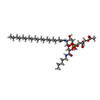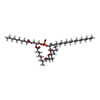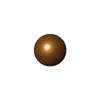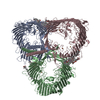[English] 日本語
 Yorodumi
Yorodumi- PDB-8acq: S-layer Deinoxanthin-Binding Complex (SDBC), subunit DR_2577 asse... -
+ Open data
Open data
- Basic information
Basic information
| Entry | Database: PDB / ID: 8acq | ||||||
|---|---|---|---|---|---|---|---|
| Title | S-layer Deinoxanthin-Binding Complex (SDBC), subunit DR_2577 assembled with its SOD DR_0644 | ||||||
 Components Components |
| ||||||
 Keywords Keywords | STRUCTURAL PROTEIN / S-layer Deinoxanthin-Binding Complex / Deinococcus radiodurans / Cell envelop / S-layer / metal binding proteins / deinoxanthin / phosphoglycolipids / copper / iron / superoxide dismutase | ||||||
| Function / homology |  Function and homology information Function and homology informationporin activity / pore complex / monoatomic ion transport / cell outer membrane / lipid binding Similarity search - Function | ||||||
| Biological species |  Deinococcus radiodurans R1 (radioresistant) Deinococcus radiodurans R1 (radioresistant) | ||||||
| Method | ELECTRON MICROSCOPY / single particle reconstruction / cryo EM / Resolution: 2.54 Å | ||||||
 Authors Authors | Farci, D. / Piano, D. | ||||||
| Funding support |  Poland, 1items Poland, 1items
| ||||||
 Citation Citation |  Journal: J Biol Chem / Year: 2023 Journal: J Biol Chem / Year: 2023Title: The SDBC is active in quenching oxidative conditions and bridges the cell envelope layers in Deinococcus radiodurans. Authors: Domenica Farci / André T Graça / Luca Iesu / Daniele de Sanctis / Dario Piano /    Abstract: Deinococcus radiodurans is known for its remarkable ability to withstand harsh stressful conditions. The outermost layer of its cell envelope is a proteinaceous coat, the S-layer, essential for ...Deinococcus radiodurans is known for its remarkable ability to withstand harsh stressful conditions. The outermost layer of its cell envelope is a proteinaceous coat, the S-layer, essential for resistance to and interactions with the environment. The S-layer Deinoxanthin-binding complex (SDBC), one of the main units of the characteristic multilayered cell envelope of this bacterium, protects against environmental stressors and allows exchanges with the environment. So far, specific regions of this complex, the collar and the stalk, remained unassigned. Here, these regions are resolved by cryo-EM and locally refined. The resulting 3D map shows that the collar region of this multiprotein complex is a trimer of the protein DR_0644, a Cu-only superoxide dismutase (SOD) identified here to be efficient in quenching reactive oxygen species. The same data also showed that the stalk region consists of a coiled coil that extends into the cell envelope for ∼280 Å, reaching the inner membrane. Finally, the orientation and localization of the complex are defined by in situ cryo-electron crystallography. The structural organization of the SDBC couples fundamental UV antenna properties with the presence of a Cu-only SOD, showing here coexisting photoprotective and chemoprotective functions. These features suggests how the SDBC and similar protein complexes, might have played a primary role as evolutive templates for the origin of photoautotrophic processes by combining primary protective needs with more independent energetic strategies. | ||||||
| History |
|
- Structure visualization
Structure visualization
| Structure viewer | Molecule:  Molmil Molmil Jmol/JSmol Jmol/JSmol |
|---|
- Downloads & links
Downloads & links
- Download
Download
| PDBx/mmCIF format |  8acq.cif.gz 8acq.cif.gz | 581.7 KB | Display |  PDBx/mmCIF format PDBx/mmCIF format |
|---|---|---|---|---|
| PDB format |  pdb8acq.ent.gz pdb8acq.ent.gz | Display |  PDB format PDB format | |
| PDBx/mmJSON format |  8acq.json.gz 8acq.json.gz | Tree view |  PDBx/mmJSON format PDBx/mmJSON format | |
| Others |  Other downloads Other downloads |
-Validation report
| Arichive directory |  https://data.pdbj.org/pub/pdb/validation_reports/ac/8acq https://data.pdbj.org/pub/pdb/validation_reports/ac/8acq ftp://data.pdbj.org/pub/pdb/validation_reports/ac/8acq ftp://data.pdbj.org/pub/pdb/validation_reports/ac/8acq | HTTPS FTP |
|---|
-Related structure data
| Related structure data |  8acaC  8agdC M: map data used to model this data C: citing same article ( |
|---|---|
| Similar structure data | Similarity search - Function & homology  F&H Search F&H Search |
- Links
Links
- Assembly
Assembly
| Deposited unit | 
|
|---|---|
| 1 |
|
- Components
Components
-Protein , 2 types, 6 molecules ABCHIL
| #1: Protein | Mass: 123835.367 Da / Num. of mol.: 3 / Source method: isolated from a natural source Source: (natural)  Deinococcus radiodurans R1 (radioresistant) Deinococcus radiodurans R1 (radioresistant)References: UniProt: Q9RRB6 #2: Protein | Mass: 20888.949 Da / Num. of mol.: 3 / Source method: isolated from a natural source Source: (natural)  Deinococcus radiodurans R1 (radioresistant) Deinococcus radiodurans R1 (radioresistant)References: UniProt: Q9RWM2 |
|---|
-Non-polymers , 5 types, 24 molecules 








| #3: Chemical | | #4: Chemical | #5: Chemical | #6: Chemical | ChemComp-CU / #7: Chemical | |
|---|
-Details
| Has ligand of interest | Y |
|---|
-Experimental details
-Experiment
| Experiment | Method: ELECTRON MICROSCOPY |
|---|---|
| EM experiment | Aggregation state: PARTICLE / 3D reconstruction method: single particle reconstruction |
- Sample preparation
Sample preparation
| Component | Name: S-layer Deinoxanthin-Binding Complex (SDBC), subunit DR_2577 assembled with its SOD DR_0644 Type: COMPLEX / Entity ID: #1-#2 / Source: NATURAL |
|---|---|
| Molecular weight | Experimental value: NO |
| Source (natural) | Organism:  Deinococcus radiodurans R1 (radioresistant) Deinococcus radiodurans R1 (radioresistant) |
| Buffer solution | pH: 7.4 |
| Specimen | Embedding applied: NO / Shadowing applied: NO / Staining applied: NO / Vitrification applied: YES |
| Vitrification | Cryogen name: ETHANE |
- Electron microscopy imaging
Electron microscopy imaging
| Experimental equipment |  Model: Titan Krios / Image courtesy: FEI Company |
|---|---|
| Microscopy | Model: FEI TITAN KRIOS |
| Electron gun | Electron source:  FIELD EMISSION GUN / Accelerating voltage: 300 kV / Illumination mode: SPOT SCAN FIELD EMISSION GUN / Accelerating voltage: 300 kV / Illumination mode: SPOT SCAN |
| Electron lens | Mode: BRIGHT FIELD / Nominal defocus max: 1000 nm / Nominal defocus min: 500 nm |
| Image recording | Electron dose: 1.3 e/Å2 / Film or detector model: GATAN K2 QUANTUM (4k x 4k) |
- Processing
Processing
| CTF correction | Type: PHASE FLIPPING AND AMPLITUDE CORRECTION |
|---|---|
| Symmetry | Point symmetry: C3 (3 fold cyclic) |
| 3D reconstruction | Resolution: 2.54 Å / Resolution method: FSC 0.143 CUT-OFF / Num. of particles: 252122 / Symmetry type: POINT |
 Movie
Movie Controller
Controller







 PDBj
PDBj










